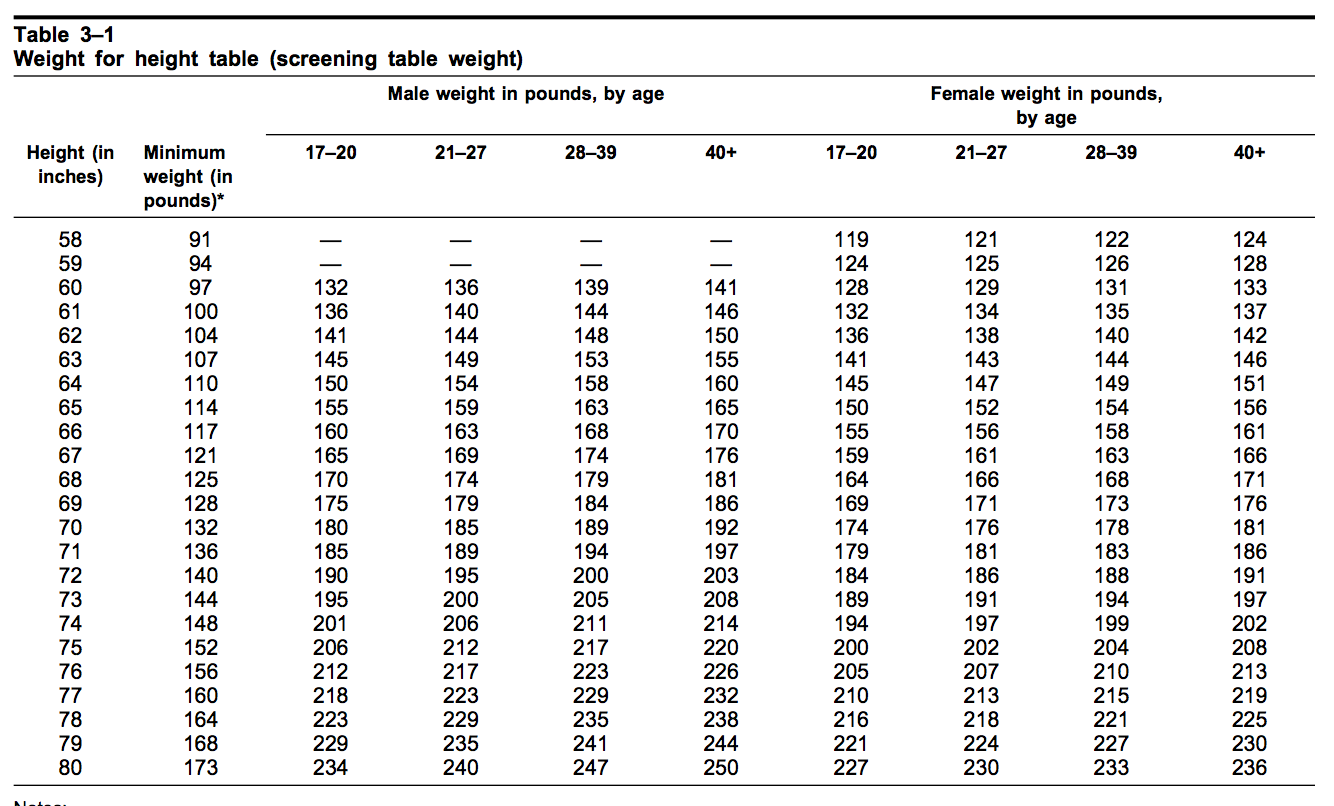The Army height and weight chart is a crucial component in maintaining the physical standards required for military service. This chart serves as a guideline for assessing whether a soldier meets the necessary physical criteria to ensure operational effectiveness. In this article, we will explore the intricacies of the Army height and weight chart, its significance, and how it impacts soldiers' careers.
Understanding the requirements set by the Army can help potential recruits prepare effectively, while current soldiers can stay informed to maintain their physical readiness. The Army emphasizes the importance of physical fitness, and being aware of the height and weight standards is an essential part of that commitment. With the right knowledge, soldiers can ensure they meet these crucial requirements throughout their service.
This guide will delve into the specifics of the Army height and weight chart, including the factors that influence these standards, how they are measured, and the consequences of not meeting them. We will also provide practical tips for soldiers and recruits on how to achieve and maintain the desired measurements.
Table of Contents
- 1. What is the Army Height and Weight Chart?
- 2. Importance of the Army Height and Weight Standards
- 3. How the Army Measures Height and Weight
- 4. Understanding Body Composition
- 5. Consequences of Not Meeting Standards
- 6. Tips for Meeting Height and Weight Requirements
- 7. Resources for Soldiers
- 8. Conclusion
1. What is the Army Height and Weight Chart?
The Army height and weight chart is a standardized tool used to evaluate the physical fitness of soldiers. It provides a range of acceptable weights for specific heights, ensuring that soldiers maintain a healthy body composition. Each branch of the military has its own chart, but they generally follow similar guidelines based on age and gender.
1.1 Overview of the Chart
The chart categorizes soldiers into various groups, taking into account factors such as age, gender, and height. It is essential for ensuring that all personnel meet the Army's physical readiness standards. The height and weight chart is updated periodically to reflect changes in military requirements and health standards.
2. Importance of the Army Height and Weight Standards
Maintaining the Army's height and weight standards is critical for several reasons:
- Operational Readiness: Soldiers need to be physically fit to perform their duties effectively.
- Health Considerations: Meeting these standards helps prevent health issues related to obesity and poor fitness.
- Professionalism: Soldiers are representatives of the Army and are expected to maintain a professional appearance.
3. How the Army Measures Height and Weight
The measurement process is straightforward but must be conducted under specific conditions to ensure accuracy:
- Height is measured in inches, without shoes, using a stadiometer.
- Weight is recorded in pounds, using a calibrated scale.
- Measurements should be taken at the same time of day for consistency.
4. Understanding Body Composition
Body composition plays a significant role in determining a soldier's overall fitness. The Army uses the body mass index (BMI) as a preliminary measure, but it also considers the percentage of body fat. Soldiers may undergo additional assessments to evaluate their body composition more accurately.
4.1 Body Fat Measurement
Body fat can be measured using various techniques, including:
- Skinfold calipers
- Bioelectrical impedance analysis (BIA)
- Hydrostatic weighing
5. Consequences of Not Meeting Standards
Failing to meet the height and weight standards set by the Army can lead to serious consequences, such as:
- Adverse Actions: Soldiers may face disciplinary actions, including counseling and remediation programs.
- Deployment Restrictions: Soldiers who do not meet standards may be restricted from deployment.
- Impact on Career Progression: Failing to maintain weight standards can hinder promotions and other career opportunities.
6. Tips for Meeting Height and Weight Requirements
Staying within the height and weight standards requires dedication and a proactive approach. Here are some tips:
- Regular Exercise: Engage in a balanced workout routine that includes cardio and strength training.
- Healthy Eating: Focus on a diet rich in fruits, vegetables, lean proteins, and whole grains.
- Hydration: Drink plenty of water to maintain optimal hydration levels.
- Seek Guidance: Work with a fitness trainer or nutritionist to create a personalized plan.
7. Resources for Soldiers
Several resources can help soldiers meet their height and weight requirements, including:
- Army Physical Fitness School: Offers guidelines and training programs.
- Nutrition Programs: Provides information on healthy eating and meal planning.
- Fitness Apps: Utilize technology to track workouts and nutrition.
8. Conclusion
In conclusion, understanding the Army height and weight chart is essential for all soldiers and recruits. Maintaining the required standards is not only crucial for operational readiness but also for personal health and career advancement. By following the tips and utilizing available resources, soldiers can successfully meet these standards and contribute to the overall effectiveness of the Army.
If you found this article helpful, please leave a comment below, share it with your fellow soldiers, or explore more articles on our site to stay informed and engaged!
Thank you for reading, and we hope to see you back on our site for more valuable insights!
You Might Also Like
The Actor With The Nose: A Deep Dive Into The Unique Charm Of Distinctive FeaturesDrake's Girlfriends: A Complete Look At His Romantic History
Brave Hannapunzel: A New Perspective On A Classic Tale
Understanding Cholesterol In Ramen Noodles: A Comprehensive Guide
Understanding Ronnie Radke's Family: A Deep Dive
Article Recommendations


